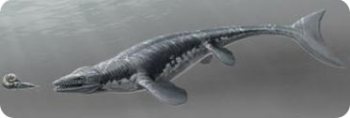Imagine a Komodo dragon the size of a large whale and you've got a rough picture of the mosasaur, one of the most fearsome predators in the oceans' history.
 Illustration of a mosasaur. Credit: Stephanie Abramowicz, Dinosaur Institute, Natural History Museum of Los Angeles County
Illustration of a mosasaur. Credit: Stephanie Abramowicz, Dinosaur Institute, Natural History Museum of Los Angeles CountyTop ocean predators of their time, mosasaurs were a group of carnivorous marine reptiles that lived during the Cretaceous period, roughly 90 million to 65 million years ago. Mosasaurs are thought to be related to present-day monitor lizards, and their fossilized remains have been found in many parts of the world.
Scientists believe these real-life sea monsters evolved from less imposing land-dwelling reptiles. As Earth experienced warming temperatures and rising sea levels during the Cretaceous, some reptiles moved back into the ocean.
Dallasaurus , a creature whose remains were found in North Texas, was one of the first mosasaurs to make the move. This diminutive, three-feet-long reptile was amphibious swam in shallow waters but had fingers and claws that allowed it to move about on land.
As mosasaurs continued to evolve, later species adapted to a completely aquatic lifestyle. They developed streamlined bodies, and their fingers were replaced with paddle-like limbs. They also grew in size, with later species reaching monstrous proportions. One of the most advanced species, Mosasaurus hoffmannii, is thought to have been the largest marine reptile that ever lived, reaching 57 feet in length!
Mosasaurs died out in a mass extinction at the end of the Cretaceous, along with land-dwelling dinosaurs. However, scientists still have much to learn from mosasaur fossils about how evolution equips animals for life at sea.


